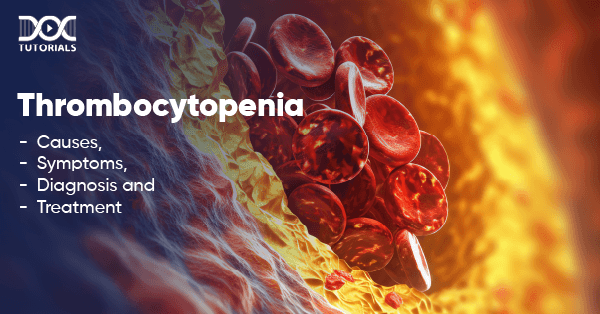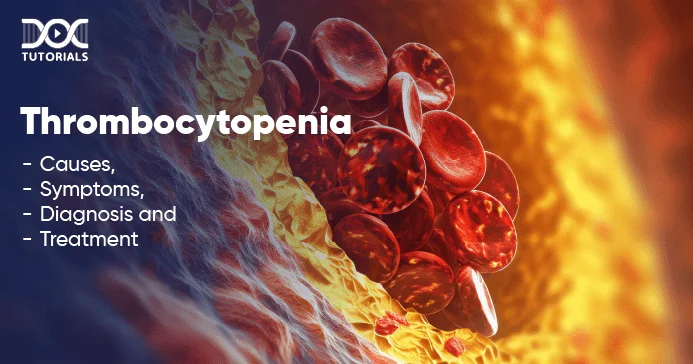Thrombocytopenia: Causes, Symptoms, Diagnosis, and Treatment

Thrombocytopenia, or low platelet count, occurs when the body does not make enough platelets or loses them too fast. It is a relatively common medical condition that affects about 5% to 12% of the Indian population.
There can be several causes behind thrombocytopenia, including bone marrow disorders, autoimmune diseases, certain medications, etc. Moreover, it can affect children and adults, and its intensity can range from milder to more severe, occasionally leading to life-threatening internal bleeding.
Understanding about thrombocytopenia is vital to ensure a timely diagnosis and proper treatment. Here’s a complete guide to thrombocytopenia, its causes, risk factors, symptoms, diagnosis, and treatment.
What is Thrombocytopenia?
Thrombocytopenia is a medical condition in which a person has an abnormally low level of platelets in the blood. Platelets (thrombocytes) are small fragments in the blood that help prevent excessive bleeding by clotting wounds. Low platelet levels can impact the body’s ability to stop bleeding, which could result in serious complications.
Here are a few points to consider in this regard:
- The normal range for platelet count is usually between 150,000 and 450,000 per microliter of blood. Thrombocytopenia is diagnosed in patients when the count drops below this threshold.
- The severity of this condition can range from mild cases with negligible effects to severe cases with a highly increased risk of bleeding.
- Depending on the underlying cause of abnormal platelet production, persistence, or distribution in the body, thrombocytopenia can be an acute medical issue or a chronic disease.
What Causes Thrombocytopenia?
Find the major causes of thrombocytopenia explained below:
Inadequate Production of Platelets
- Bone Marrow Disorders: Leukaemia, aplastic anaemia, and myelodysplastic syndromes affect platelet production.
- Nutritional Deficiencies: Low vitamin B12 or folate hinders production.
- Cancer Treatment: Bone marrow can be affected by chemotherapy and radiation therapy.
Increased Platelet Destruction
- Immune System Disorders: Autoimmune diseases like Immune Thrombocytopenic Purpura (ITP), lupus, and rheumatoid arthritis result in immune-mediated platelet destruction.
- Medications: Drugs such as heparin, quinine and some antibiotics cause an immune response that destroys platelets.
- Infections: Immune-mediated platelet destruction occurs in some viral infections, including human immunodeficiency virus (HIV), human hepatitis C virus, and parvovirus B19.
Platelet Trapping
- Splenomegaly (Enlarged Spleen): Conditions such as cirrhosis can cause the spleen to enlarge and store platelets for the organ, thus lowering the availability of platelets in the blood.
What are the Risk Factors of Thrombocytopenia?
The risk factors for thrombocytopenia include various diseases, lifestyle factors and environmental exposures, such as:
- Aplastic anaemia, leukaemia, lymphoma, and myelodysplastic syndromes are bone marrow conditions that can reduce its ability to make platelets.
- Diseases such as lupus, rheumatoid arthritis, and immune thrombocytopenic purpura (ITP full form) instigate platelet destruction by inducing an immune response to platelets.
- Thrombocytopenia due to immune-mediated platelet destruction are also seen in infections such as HIV, hepatitis C and other viral infections.
- Some medications (e.g., heparin, quinine, sulfa-containing antibiotics, and some cancer therapies) can cause thrombocytopenia via decreased production or an immune response against platelets.
- High doses of alcohol may also affect platelet production in the bone marrow.
- Some conditions can cause nutritional deficiency, like a lack of vitamin B12 or folate, which can affect the production of platelets and cause thrombocytopenia.
- Genetic disorders, such as Wiskott-Aldrich syndrome, present a higher risk of developing thrombocytopenia.
- Pregnancy may cause mild thrombocytopenia that will likely resolve with delivery.
- Liver diseases, such as cirrhosis, can cause an enlarged spleen, which traps and stores platelets, preventing them from reaching the bloodstream.
- Toxic chemicals, such as pesticides, arsenic, and benzene, can inhibit the production of platelets.
- A few cancers and their treatments, like chemotherapy, may impact one’s platelet counts.
What are the Symptoms of Thrombocytopenia?
Thrombocytopenia leads to a spectrum of bleeding-related symptoms in the body that can also vary in severity. Some individuals may experience no apparent symptoms at all, particularly in mild cases. But when symptoms of low platelets do occur, they tend to include the following:
Common Symptoms
- Easy Bruising: Bruises occur easily and may be larger than expected.
- Abnormal Bleeding: Frequent nosebleeds, bleeding gums or excessive bleeding from small cuts.
- Heavy Menstrual Periods: Menstrual bleeding can be prolonged or heavy (menorrhagia).
- Blood in Urine (Hematuria): Urine can turn pink or red due to the presence of blood.
- Blood in the Stool (Melena or Hematochezia): Dark, tarry stools or red blood in the stool may indicate internal bleeding.
- Prolonged Bleeding from Cuts: Cuts may bleed longer than normal.
Skin and Mucosal Symptoms
- Petechiae: Small red or purple pinpoint dots on the skin, usually seen predominantly on the lower legs.
- Purpura: Bigger red, purple or brown spots from blood seeping below the skin.
- Bruising: Bruising happens often without injury.
Severe Symptoms
- Blood in Vomit (Hematemesis): Vomiting blood could indicate internal bleeding.
- Rectal Bleeding: Blood in toilet water or on tissue after wiping.
Severe thrombocytopenia is a cause of spontaneous internal bleeding, a situation that can be a medical emergency requiring immediate attention.
How to Diagnose Thrombocytopenia Condition?
Thrombocytopenia diagnosis is based on clinical and laboratory examination. Your doctor will usually begin with your medical history and a physical exam for signs of bleeding or an enlarged spleen. The following tests may be suggested:
- Complete Blood Count (CBC): Checks platelet count & other blood cells.
- Peripheral Blood Smear: The morphology of platelets is studied under a microscope.
- HIV and HCV Tests: Assists in detecting infections caused by the human immunodeficiency virus (HIV) and the hepatitis C virus (HCV) that could lead to thrombocytopenia.
- Bone Marrow Aspiration and Biopsy: These tests may help evaluate the bone marrow status and platelet production.
- Other Tests Include: Prothrombin Time (PT) and Partial Thromboplastin Time (PTT) tests to assess blood clotting and an ultrasound to look for spleen enlargement.
Your doctor might refer you to a haematologist for additional evaluation and management. Additional blood tests may be done to evaluate the condition of the blood and identify the underlying cause of thrombocytopenia, which is vital in planning effective treatment.
What are the Treatment Options for Thrombocytopenia?
Thrombocytopenia treatment depends on its severity and underlying cause. Some people may not need treatment, while others can require medical intervention.
Medical Treatments
- Steroids: Corticosteroids can suppress the immune system to prevent platelet destruction.
- Blood or Platelet Transfusions: Used in severe cases to temporarily increase platelet levels.
- Medications: Drugs like immunosuppressants or thrombopoietin receptor agonists may help if the condition is immune-related.
- Plasma Exchange: Used in emergency thrombotic thrombocytopenic purpura (TTP) cases.
Surgical & Lifestyle Treatments
- Splenectomy: Surgery to remove the spleen if it traps too many platelets.
- Changing Medications: If thrombocytopenia is drug-induced, switching to an alternative may resolve the issue.
- Managing Underlying Conditions: Treating conditions like liver disease or infections can improve platelet counts.
Supportive Care
- Avoiding Certain Medications: Nonsteroidal anti-inflammatory drugs (NSAIDs) like aspirin can worsen platelet function.
- Dietary Adjustments: Ensuring adequate vitamin B12 and folate intake to support platelet production.
Consulting a healthcare provider ensures that the right treatment for thrombocytopenia is chosen based on individual needs. Early intervention can help manage the condition effectively.
FAQs About Thrombocytopenia
- What are the main causes of thrombocytopenia?
Thrombocytopenia can be caused by decreased platelet production, increased destruction, or excessive platelet trapping. Common causes include bone marrow disorders, autoimmune diseases like ITP, viral infections, certain medications, chemotherapy, heavy alcohol use, and an enlarged spleen.
- Can you live a normal life with thrombocytopenia?
Yes, many people having mild thrombocytopenia live normal lives with proper management. Avoiding injury, following medical advice, and treating underlying causes help maintain a good quality of life.
- How can I reduce my risk of developing thrombocytopenia?
Understanding your medical conditions and medications is key. If you’re at risk, consult your doctor about lifestyle changes, avoiding certain drugs, and maintaining a healthy diet to support platelet production.
- Can thrombocytopenia be cured?
Thrombocytopenia can sometimes be cured if the underlying cause is treatable. In other cases, long-term management with medications, lifestyle changes, or medical procedures is necessary.
- Is thrombocytopenia high risk?
Severe thrombocytopenia can be high-risk, leading to dangerous internal or external bleeding. Proper treatment and monitoring help reduce complications and prevent life-threatening situations.
Conclusion
Thrombocytopenia can range from mild cases with no symptoms to severe cases requiring urgent care. Common symptoms include easy bruising, prolonged bleeding, and petechiae. Diagnosis involves blood tests, bone marrow evaluation, and screening for underlying conditions like ITP.
Treatment varies based on severity, from medications and lifestyle changes to platelet transfusions or splenectomy. Early detection and proper management can prevent complications, especially for those at risk. For medical aspirants, DocTutorials offers detailed information on more such topics. Check out our NEET PG course for a 360-degree learning solution, including tests with video explanations, question banks, quick revision programs, and more.
Latest Blogs
-

NEET PG Exam 2025- Date, Pattern, Marking Scheme, Subject Wise Weightage, and Exam Mode
NEET PG Exam 2025 is the ultimate gateway for medical graduates aspiring to pursue postgraduate courses in medicine, including MD,…
-

INI CET Exam 2025: Your Roadmap to Success – Key Topics, Strategies, and Lessons from Last Year’s Papers
The INI CET exam is more than just a test; it’s a significant milestone for many medical students aiming to…
-

INI CET Exam Success: Previous Year Question Papers & Ultimate Guide – INI CET PYQ
One can feel overwhelmed while preparing for the INI CET (Institute of National Importance Combined Entrance Test). A vast syllabus,…





